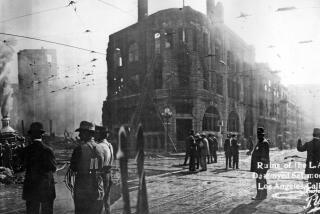Voices from The Times newsroom past and present on issues of race
Janet Clayton, former staff writer, editor of the editorial pages and Metro editor
I am a native Angeleno and was a longtime journalist at this newspaper, so people often assume I must have grown up reading the L.A. Times. Nope. Not a chance.
That’s because my father, an elevator operator and union man who worked for the county, would not bring The Times into our home. A soft-spoken refugee from east Texas, he had few hard and fast rules for his two daughters. He was the soft touch; the discipline was left to my mom. But one of the things he would not abide was to see a copy of The Times in our hands.
As a child I didn’t know and didn’t care why my dad had such a bad reaction to the paper. I had the Herald Examiner for reading the funny pages, and my desire to be in the know was fulfilled by the neighborhood Southwest Wave and the Sentinel. Who needed that bigger, boring-looking paper, in which Black people — when mentioned — were often described as “burly Negroes,” or in the case of future Mayor Tom Bradley, “militant”?
I ended up being a reporter for The Times, and eventually editor of the editorial pages and Metro editor. My dad died before he saw any of that happen for me. I wish he could have witnessed the change — my mom did, with her eyes full of tears. The paper and the city it reflected did get better for Black people, at least for a while.
•••
Louis Sahagun, staff writer
The idea, hatched by a group of Latino reporters and editors at The Times in the early 1980s, was simple. We would set the record straight about a community that then totaled 3 million people by writing a series about the lives of Southern California Latinos and the increasingly important role they held in shaping the character of California and the nation. But the project was met with skepticism by many Anglo doubters in the newsroom who shrugged it off as a “lightweight” journalistic exercise and an experiment bound to fail.
At one project meeting in a bar near the newsroom, a veteran white reporter seated at a nearby table looked over his shoulder, smiled sarcastically and asked in a voice loud enough for all of us to hear, “So, when can we expect to see this debacle?”
We persisted, though, interviewing political leaders, city planners, historians, business leaders, law enforcement authorities, gang members, school officials and exemplary students in local high schools. We also examined thousands of pages of city historical records and documents and conducted dozens of man-on-the-street interviews.
After it ran in 1983, our series received an “honorable mention” at the annual Los Angeles Times editorial awards banquet held at the Beverly Hilton hotel. Soon after, we learned it had won another prize: the 1984 Pulitzer Prize for public service, journalism’s top honor. Revenge was sweet.
•••
Craig Matsuda, former editor
Shortly after arriving to work as an editor on The Times’ View section from the Denver Post’s Metro desk, I was invited by the late Frank del Olmo, then on the editorial pages, to an unusual gathering in an out-of-the-way meeting room.
Our reckoning with racism
As the country grapples with the role of systemic racism, The Times has committed to examining its past. This project looks at our treatment of people of color — outside and inside the newsroom — throughout our nearly 139-year history.
At a newspaper with a staff of many hundreds of journalists, we were the rare few in 1989: assignment editors of color. Assigning editors are the ones on the front line helping decide which stories get covered and how. They edit and manage reporters and photographers. They advise about the news’ importance and the prominence of stories’ display. And most of them back then were white.
We weren’t. And we had another common characteristic, observed Simon Li, then a “backfielder” in international news: “As I look around the room, I see we’re Black, brown and yellow, young and old, new to the paper and seasoned hands. We work across The Times. The one attribute we share is in our titles: We’re all bloody assistants.”
Over the next decade, many of the assembled assistants rose to lead key parts of the newsroom. Their presence in the top ranks mattered. Having a diverse staff at the top still matters today.
•••
Angel Jennings, assistant managing editor for culture and talent
The caller on the other end of the line had finally responded after weeks of ignoring my messages. But she hadn’t rung me to chat.
“I don’t talk to the L.A. Times,” the middle-aged Black woman said curtly. “I don’t read them. I don’t want anything to do with them. It’s the reason King/Drew hospital closed.”
The paper had won a 2005 Pulitzer Prize for an investigation revealing shockingly poor care and fatal mistakes by doctors and nurses at Martin Luther King Jr./Drew Medical Center near Watts. But many residents of South Los Angeles felt The Times had never accurately reflected their vibrant communities and neighborhoods. They saw the investigation into King/Drew as another example of the paper seeing only the area’s problems.
The hospital, however flawed, had been a place where Black doctors and nurses could train and patients could receive medical care from folks who looked like them. The Times’ series led to its closure and ultimately to a new, much-improved hospital for the community.

But at the time I sat on the line with the woman wary of the paper, the Watts area was still without a hospital, and county officials were scrambling to fund a replacement for King/Drew. She blamed the paper and ended the call.
It took much convincing to get that source to open up. And she was only one of many people I encountered during years of covering South L.A. who mistrusted me because I was from The Times. With each story I wrote, I worked to undo years of damage and rebuild trust between the paper and long-overlooked communities. We need to keep doing stories like King/Drew. But we also need to do stories about the wealth of businesses, people and institutions that enrich South L.A.
Now, in my new role as assistant managing editor for culture and talent, I get to help find and shape the next generation of writers who will tell these nuanced stories. And I will continue to push for a newsroom demographic that mirrors the city we cover so that we can better reflect the rich, diverse voices in our communities. The survival of our paper depends upon it.
•••
Pamela Moreland, staff writer and editor during the 1980s
I was the first African American to work as a journalist in the Los Angeles Times’ Business section. I started in January 1980. I was sure I could cover a business beat, and as a native Angeleno, I was also determined to make a difference in coverage and show readers the Black Los Angeles I knew.
I wrote about all the kinds of stories a general assignment business reporter covers: corporate shake-ups, bankruptcies, mergers and acquisitions. But if assigned a story on mortgage interest rates, I made sure to mention the Black-owned Broadway Federal. A story on insurance companies might include the Los Angeles-based Golden State Mutual Insurance, also a Black-owned business. My turn to take a look at the impact of the deregulation of the savings and loans industry? I wrote about the impact on minority-owned S&Ls in Southern California.
These were seemingly small additions. But by bringing in voices often ignored, I was trying to give a fuller picture of L.A.’s business world. People noticed. Inclusion makes a difference.
•••
Carlos Valdez Lozano, assistant Metro editor
In 1987, I was an intern at the paper as part of the new MetPro program to train young minority journalists. I was grateful to be at a paper I’d always admired, but it felt like some editors weren’t quite sure what to do with us.
Following the grisly murder of a young male prostitute, I wrote a story about teenage runaways in Hollywood. The features editor promised to run it. But when it finally appeared, I was shocked to discover that a white female reporter had been told to rewrite the story entirely using my sources, quotes and material. I didn’t even get a byline.
I complained bitterly. I never got an apology, but I did eventually find editors who embraced the mission of guiding inexperienced reporters of color. I also learned the importance of speaking up when you feel you’ve been treated unfairly.
I got hired and have been here for 33 years. Lesson: It’s not enough simply to bring promising young journalists of color into the newsroom. They need mentoring.
•••
William J. Drummond, Times staff writer during the 1970s
Shortly after I arrived at The Times — and became one of only two Black reporters on the city desk staff — I threw a small dinner party at my Baldwin Hills apartment. Among the guests was the late Kenneth Reich, a legendary, outspoken Times political reporter. Ken and his date were the only Caucasians who showed up. It was mid-1968 and the Rev. Martin Luther King Jr. had been killed in Memphis, and several cities had rioted. Race was, to put it mildly, a dangerously touchy subject.
After dinner we settled into drinks. Ken decided to become a provocateur. Wasn’t it self-destructive for Blacks to burn down their own neighborhoods? he asked.
To my horror, I watched as tempers and voices rose. It wasn’t long before Ken was literally backed into a corner during a heated exchange. Fortunately, everybody eventually got exhausted and went home.
I thought Ken would never speak to me again.
To my amazement, he called the next day, thanking me for the invitation, saying he found the whole group interesting and the discussion fascinating. He could not remember when he had been so stimulated.
The party was probably a landmark event for him. Black areas of town were terra incognita to The Times, in part because the majority of the editorial staff lived in majority-white neighborhoods. They simply did not know anyone Black. I had become Ken’s Black friend.
More to Read
A cure for the common opinion
Get thought-provoking perspectives with our weekly newsletter.
You may occasionally receive promotional content from the Los Angeles Times.











